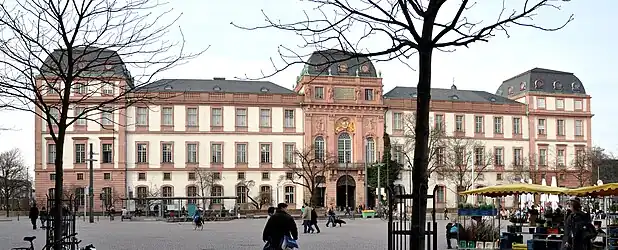| Residential Palace Darmstadt | |
|---|---|
Residenzschloss Darmstadt | |
 The Residential Palace Darmstadt | |
| General information | |
| Status | Rebuild |
| Type | Castle, Palace |
| Architectural style | Renaissance, Baroque |
| Location | City centre |
| Address | Residenzschloss 1[1] (Marktplatz 15) |
| Town or city | Darmstadt |
| Country | Germany |
| Coordinates | 49°52′24.913″N 8°39′17.748″E / 49.87358694°N 8.65493000°E |
| Elevation | 153 m (502 ft) (NHN)[2] |
| Current tenants |
|
| Groundbreaking | 13th century |
| Construction started | 1567 |
| Completed | 1726, 1960s (rebuild)[3] |
| Renovated | 2008–2023 |
| Destroyed | 1518, 1546, 1693, 11 September 1944 |
| Renovation cost | €41-million[4] |
| Client |
|
| Owner | TU Darmstadt |
| Technical details | |
| Structural system | Old castle and Neuschloss |
| Floor count | 3 (Neuschloss) |
| Floor area | 23,000 m2 (250,000 sq ft) |
| Design and construction | |
| Architect(s) |
|
| Other information | |
| Parking | Schlossgarage |
| Public transit access | Tram, bus: Schloss |
The Residential Palace Darmstadt (German: Residenzschloss Darmstadt, often also called Stadtschloss) is the former residence and administrative seat of the landgraves of Hesse-Darmstadt and from 1806 to 1919 of the Grand Dukes of Hesse-Darmstadt. It is located in the centre of the city of Darmstadt. The palace consists of an older Renaissance part and an 18th century Baroque part.
As of 2023, the castle is the seat of the Technische Universität Darmstadt and the German-Polish Institute.
History
Middle Ages
The origins of the castle lie in the Katzenelnbogen time.[7] In the middle of the 13th century the counts of Katzenelnbogen built a moated castle in Darmstadt.[7] In 1330 Darmstadt received town rights,[8][9] one year later the castle is mentioned for the first time in a document.[10] From 1386, the moated castle lost importance and became a widow's residence and secondary residence.[11] In the following two centuries, the counts of Katzenelnbogen extended and rebuilt the castle again and again. Until the middle of the 15th century the castle was transformed into a representative castle and Darmstadt became Katzenelnbogen's second residence.[12] What remains of the moated castle are the form of the central church courtyard and the outer walls of the manor house. When the last count von Katzenelnbogen died in 1479, Darmstadt fell to Henry III, Landgrave of Upper Hesse.[7] When Philip I took over the government offices in 1518, the castle was destroyed for the first time in an attack by Franz von Sickingen.[10] The castle was rebuilt in the following years, but with essentially the same defensive structures. During the Schmalkaldic War in 1546 it was destroyed again by imperial troops.[7]
Renaissance era

Landgrave George I considerably extended the castle from 1567 to a Renaissance complex and secured it with moats and bastions. The half-timbered floors of the former palace and the hall are rebuilt from stone. The buildings received new roofs. Christoph Müller and Jakob Wustmann[14] developed the old moated castle into a residential palace.[7] After 1589 the office, the stables and the arsenal were built, which no longer exist today.[15] From 1594, the landgrave had orphans educated in the castle. From 1595 to 1597 the Kaisersaal (Emperor's room) and the church were built. The tympanum corridor (Paukergang), which connects the manor with the church, was also built.[11][7][16][15]
The Wallhäuschen, a gate building in the north of the castle, was built in 1627 by Jakob Müller. The bell building was built from 1663 to 1671 according to plans by the architect Johann Wilhelm Pfannmüller. The bells were delivered by Piter Hemony.[17] Darmstadt was attacked by the French in 1693 and the castle burned down.[18]
Baroque era
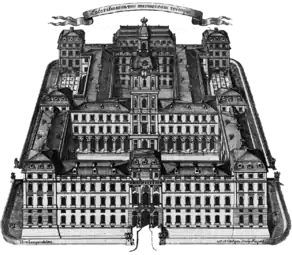
Landgrave Ernst Ludwig commissioned the French architect Louis Remy de la Fosse to plan a new baroque palace with four large wings in 1715, after the palace's chancellery had burned down.[7] This was to completely replace the old palace. Due to lack of money, however, only two wings were completed by 1726. These were to remain the last major structural changes to the castle. When Hessen-Darmstadt joined the Confederation of the Rhine in 1806, the castle became the seat of the Grand Dukes of Darmstadt.[19] At the beginning of the 19th century, the upper floors of the new castle were furnished and fitted with window glazing.[11] In 1842, the university and state library and the grand ducal collection with natural history cabinet moved in.[11] Since the 18th century the castle has been less and less inhabited by the grand dukes and other members of the ruling family who settled in more comfortable premises, most of which were destroyed in World War II. These included the Altes Palais and Alexanderpalais on Luisenplatz, the Neues Palais and Prinz-Carl-Palais to the south, the Prinz-Georg-Palais to the north, and the Palais Rosenhöhe near the family's burial grounds in Rosenhöhe Park to the east. Meanwhile, more and more institutions were admitted in the vacant old residential palace and some of the rooms were reserved for state guests.[11][7][16][15]
20th century
In 1893, under Ernst Ludwig, Grand Duke of Hesse and by Rhine, structural measures were again being taken. Thus the extension with a tea pavilion was built on the Herrenbau. In 1924, the castle museum moved into the old area of the castle.[11][7][15]
After the World War I, the castle passed into the possession of the People's State of Hesse. On the night of the fire in Darmstadt from 11 to 12 September 1944, the castle burned down to the outer walls.[20][21] Reconstruction began in 1946 and was not completed until the early 1970s.[10] An overall repair was carried out in 2008, which is planned to last for a longer period of time.[22] The bell construction was completed in 2016.[23] The outer appearance was almost completely restored.[23] As of 2023, the castle is the seat of the Technische Universität Darmstadt and the German-Polish Institute.[11][16][15][24]
Construction
Residenzschloss (Residential Palace Darmstadt)
The castle is divided into three areas: the outer fortification including Schlossgraben,[25][7][11] the Renaissance castle and the Baroque castle (De-la-Fosse-Bau).[26]
The north is occupied by a park that belongs to the old fortification.[27][25] In its place was once the deep moat that completely surrounded the castle.[25]
The centerpiece of the Residential Palace Darmstadt is the old Renaissance palace. It still has the almost triangular shape of the old core castle and consists of the castle wings Herrenbau, Weißer Saalbau, Kaisersaalbau, Kirchenbau and the church courtyard.[23][28] In the southeast is the bell building.[29][17][30]
The Baroque part of the castle (De-la-Fosse-Bau or Neuschloss) consists of a three-storey[10] southern and west wing on an angular floor plan.[26] From the town, a fortified gate leads directly through the baroque castle into the southern courtyard.[31]
The usable area is 23,000 m2 (250,000 sq ft), owner is the Technische Universität Darmstadt.[4]
Buildings
- Wallhaus (wall building)[32]
- Brückenhaus (bridge building)[32]
- Herrenbau, German-Polish Institute (manor)[33]
- Weißer Saalbau, Schlosskeller, Department of History and Social Sciences (white hall)[23][34]
- Kaisersaalbau (emperor's hall)[32]
- Kirchenbau, Orgelsaal, Schlossmuseum (church building, organ hall, palace museum)[33][35][36][37]
- Glockenbau with Glockenspiel, Schlossmuseum (bell building with carillon, palace museum)[32]
- Prinz-Christian-Bau (Prince Christian building)[23]
- De-la-Fosse-Bau,[38] Library Department of History and Social Sciences, Executive Board of TU Darmstadt (Baroque castle)[32]
Courtyards
Corridors
- Paukergang[11]
Bridges
- Wallbrücke (wall bridge, north entrance)[33]
- Marktbrücke (south main entrance)
- Parforce-Brücke (west entrance)
Outer fortifications
Source:[3]
Location
The castle is located in the centre of Darmstadt. Nearby are the Marktplatz (market square) and Altes Rathaus (town hall) in the South.[7] The Hessisches Landesmuseum Darmstadt by Alfred Messel, the neoclassical former court theatre Haus der Geschichte Darmstadt (House of History) by Georg Moller,[42] the square Karolinenplatz are situated in the North.[43] The square Friedensplatz and street Rheinstraße are located in the West.[44]
City Centre Darmstadt
Gallery
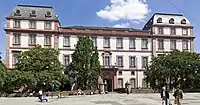 The castle seen from the West
The castle seen from the West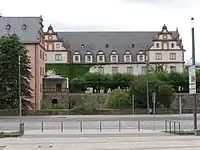 The castle seen from the East, Kirchenbau
The castle seen from the East, Kirchenbau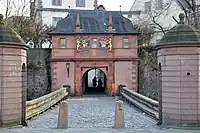 Brückenhaus and Wallbrücke seen from the North
Brückenhaus and Wallbrücke seen from the North Schlossgraben (castle moat) in 2014
Schlossgraben (castle moat) in 2014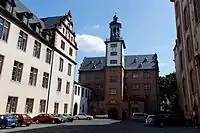 Glockenbau and Glockenhof
Glockenbau and Glockenhof Aerial view with the castle in the centre
Aerial view with the castle in the centre
Schlossmuseum
The palace museum shows objects belonging to the former landgraves and Grand Dukes of Hesse-Darmstadt.[37][45] Opened in 1924,[46][47] the museum is located in the bell and church building of the residential palace.[37]
Schlosskeller
The Schlosskeller is an event location and a club in the basement of the castle. Since 1966, the club has been run by students.[34][48]
Music festival Schlossgrabenfest
Since 1999 the Schlossgrabenfest, the largest music festival in Hesse and one of the largest open-air events in Germany, has taken place every year on the last weekend of May around the Residential Palace Darmstadt and Friedens- und Karolinenplatz in Darmstadt. The musical spectrum ranges from rock, pop, electro, reggae and hip-hop to soul and jazz.[49][50][51]
Royal Ghost Story
According to several witnesses, including Frederica of Mecklenburg-Strelitz, Duchess of Cumberland and later Queen of Hanover, the ghost of the old Duchess of Darmstadt was seen in one of the rooms of the palace.[52]
See also
References
- ↑ ""Residenzschloss 1": Neue Adresse fürs Schloss". TU Darmstadt (in German). 28 July 2022. Archived from the original on 17 January 2023. Retrieved 17 January 2023.
- ↑ "Schloss Darmstadt". Landesgeschichtliches Informationssystem Hessen (LAGIS) (in German). Archived from the original on 23 February 2022. Retrieved 8 January 2023.
- 1 2 "Neuer Glanz für Darmstadts Wahrzeichen". TU Darmstadt (in German). 8 April 2013. Archived from the original on 17 May 2022. Retrieved 18 January 2023.
- 1 2 Pipke, Anke (9 April 2013). "Darmstädter Schloss wird für 41 Mio. Euro saniert". Immobilien Zeitung (in German). Archived from the original on 3 August 2023. Retrieved 18 January 2023.
- ↑ "Lechler, Lorenz". Deutsche Biographie (in German). Archived from the original on 21 January 2023. Retrieved 21 January 2023.
- ↑ Hubach, Hanns (2014), ""Architectus HeidelbergensisS illustrissimo prinicpi Othoni Henrico". Materialien zur Biographie des Steinmetzen und Architekten Heinrich Gut", "Architectus Heidelbergensis illustrissimo prinicpi Othoni Henrico". Materialien zur Biographie des Steinmetzen und Architekten Heinrich Gut, Heidelberg University Library, p. 164, doi:10.11588/ARTDOK.00002561, retrieved 21 January 2023
- 1 2 3 4 5 6 7 8 9 10 11 "Schloss und Marktplatz: Darmstadt". www.darmstadt.de. Archived from the original on 14 November 2019. Retrieved 1 November 2019.
- ↑ "Stadtgeschichte". Stadtlexikon Darmstadt (in German). Archived from the original on 17 January 2023. Retrieved 17 January 2023.
- ↑ Darmstadt, Wissenschaftsstadt. "Stadtporträt: Darmstadt". Home (in German). Archived from the original on 26 January 2023. Retrieved 18 January 2023.
- 1 2 3 4 Hein, Andreas. "Schloss Darmstadt (Residenzschloss) in Darmstadt". Burgendatenbank und Burgenatlas (in German). Archived from the original on 7 December 2022. Retrieved 17 January 2023.
- 1 2 3 4 5 6 7 8 9 "Schloss". Stadtlexikon Darmstadt (in German). Archived from the original on 3 January 2023. Retrieved 17 January 2023.
- ↑ "Katzenelnbogen, Grafen von". Stadtlexikon Darmstadt (in German). Archived from the original on 17 January 2023. Retrieved 18 January 2023.
- ↑ "Rodingh, Pieter: Fürstl. Hessen Darmstat. ResidensSchlos. [Mit Widmung für:] Ludwig VI. und Elisabeth Dorothea. [Mitte unten:] Anno 1676 P: Rodingh Fürstl: Hessen Darmstatt Hof-Mahler Invent: Pinxit Et Sculpsit (Darmstadt, 1676)". Universitäts- und Landesbibliothek – TU Darmstadt (in German). 22 February 2021. Archived from the original on 19 January 2023. Retrieved 19 January 2023.
- ↑ "Wustmann, Jakob". Deutsche Biographie (in German). Archived from the original on 19 January 2023. Retrieved 19 January 2023.
- 1 2 3 4 5 Darmstadt, Technische Universität (8 April 2013). "Das Darmstädter Residenzschloss – eine Chronik". Technische Universität Darmstadt (in German). Retrieved 23 November 2019.
- 1 2 3 Darmstadt, Technische Universität. "baubeschreibung". Technische Universität Darmstadt (in German). Archived from the original on 22 June 2016. Retrieved 23 November 2019.
- 1 2 "Glockenspiel". Stadtlexikon Darmstadt (in German). Archived from the original on 17 January 2023. Retrieved 17 January 2023.
- ↑ "Das Residenzschloss Darmstadt – Infos, Bilder und mehr". Burgenarchiv.de (in German). 5 April 2019. Archived from the original on 20 January 2023. Retrieved 20 January 2023.
- ↑ "Hesse-Darmstadt – former landgraviate, Germany". Encyclopedia Britannica. 20 July 1998. Archived from the original on 18 January 2023. Retrieved 18 January 2023.
- ↑ "Schwere Zerstörungen in den Darmstädter Bibliotheken durch Luftangriff der Royal Air Force, 11.-12. September 1944". Zeitgeschichte in Hessen (in German). Archived from the original on 19 January 2023. Retrieved 19 January 2023.
- ↑ "Schlossmuseum". DFG-VK Darmstadt (in German). Archived from the original on 10 August 2022. Retrieved 19 January 2023.
- ↑ "Neuer Glanz für ein Darmstädter Wahrzeichen – Technische Universität beginnt Sanierung des Darmstädter Residenzschlosses". DarmstadtNews.de (in German). 8 April 2013. Archived from the original on 19 January 2023. Retrieved 19 January 2023.
- 1 2 3 4 5 "Schloss-Sanierung verzögert sich". Frankfurter Rundschau (in German). 28 July 2016. Archived from the original on 17 January 2023. Retrieved 17 January 2023.
- ↑ "Deutsches Polen-Institut". Deutsches Polen-Institut (in German). Archived from the original on 29 January 2023. Retrieved 17 January 2023.
- 1 2 3 "Flanieren am Schloss". Frankfurter Rundschau (in German). 14 March 2012. Archived from the original on 17 January 2023. Retrieved 17 January 2023.
- 1 2 Rhein, Boris; Prömel, Hans Jürgen; et al. (2020). 450 Jahre Wissen – Sammeln – Vermitteln. Von der Hof- zur Universitäts- und Landesbibliothek Darmstadt : 1567–2017. Justus von Liebig Verlag. p. 105. doi:10.25534/TUPRINTS-00006838. ISBN 978-3-87390-402-6. Archived from the original on 3 August 2023. Retrieved 16 January 2023.
- ↑ Hein, Rainer (14 March 2012). "Darmstadt: Zur Mittagspause in den Schlossgraben". FAZ.NET (in German). Archived from the original on 17 January 2023. Retrieved 17 January 2023.
- ↑ "Schloss: Ältester Keller Darmstadts entdeckt". TU Darmstadt (in German). 30 March 2011. Archived from the original on 17 January 2023. Retrieved 17 January 2023.
- ↑ "Neue Töne vom Darmstädter Glockenspiel". TU Darmstadt (in German). 2 May 2011. Archived from the original on 17 January 2023. Retrieved 17 January 2023.
- ↑ "Darmstadt: Einbrecher setzt Schlossmuseum unter Wasser". Der Spiegel (in German). 30 March 2018. Archived from the original on 17 January 2023. Retrieved 17 January 2023.
- ↑ Baier, Joachim (19 October 2013). "Darmstädter Schloss wird auf Vordermann gebracht". Region Bergstraße (in German). Archived from the original on 17 January 2023. Retrieved 17 January 2023.
- 1 2 3 4 5 "Gebäudeadressen". TU Darmstadt (in German). Archived from the original on 17 January 2023. Retrieved 17 January 2023.
- 1 2 3 4 5 "Neue Wege zum Museum". Frankfurter Rundschau (in German). 16 July 2015. Archived from the original on 17 January 2023. Retrieved 17 January 2023.
- 1 2 "Schlosskeller Darmstadt". Schlosskeller Darmstadt (in German). Archived from the original on 17 January 2023. Retrieved 17 January 2023.
- ↑ "Schlosskirche". TU Darmstadt (in German). Archived from the original on 19 January 2023. Retrieved 19 January 2023.
- ↑ "Darmstadts Schlossorgel". TU Darmstadt. Archived from the original on 19 January 2023. Retrieved 19 January 2023.
- 1 2 3 Schiefenhöfel, Jan (22 September 2016). "Darmstädter Schlossmuseum: Mit neuem Konzept für mehr Besucher". FAZ.NET (in German). Archived from the original on 21 January 2023. Retrieved 21 January 2023.
- ↑ "Residenzschloss, Darmstadt". rbw-bau (in German). Archived from the original on 17 January 2023. Retrieved 17 January 2023.
- ↑ "Keller-Klub Darmstadt e.V." Keller-Klub Darmstadt e.V. (in German). 12 December 2011. Archived from the original on 8 February 2023. Retrieved 18 January 2023.
- ↑ Hein, Rainer (16 June 2014). "Schlossgraben Darmstadt: "Eine Oase mitten in der Stadt"". FAZ.NET (in German). Archived from the original on 21 January 2023. Retrieved 21 January 2023.
- ↑ Kabel, Claudia (10 March 2021). "Darmstadt: Tonnenschwere Skulptur in Schlossgraben gehievt". Frankfurter Rundschau (in German). Archived from the original on 21 January 2023. Retrieved 21 January 2023.
- ↑ "Official". Haus der Geschichte (in German). Archived from the original on 9 November 2022. Retrieved 17 January 2023.
- ↑ Darmstadt, Wissenschaftsstadt. "Friedensplatz ist fertiggestellt". Darmstadt (in German). Archived from the original on 17 January 2023. Retrieved 17 January 2023.
- ↑ Darmstadt, Wissenschaftsstadt. "Antwort auf Kleine Anfrage: Oberbürgermeister Jochen Partsch stellt Neuordnung der Verkehrsführung auf B26 zwischen Friedensplatz und Landesmuseum in Aussicht". Darmstadt (in German). Archived from the original on 17 January 2023. Retrieved 17 January 2023.
- ↑ "home". Schlossmuseum Darmstadt. 18 July 2022. Archived from the original on 21 January 2023. Retrieved 21 January 2023.
- ↑ "In Darmstadt wird das in den Räumen des Residenzschlosses gelegene Schlossmuseum der Öffentlichkeit zugänglich gemacht, 11. Mai 1924". Zeitgeschichte in Hessen (in German). Archived from the original on 21 January 2023. Retrieved 21 January 2023.
- ↑ "Museum". Schlossmuseum Darmstadt (in German). 15 April 2022. Archived from the original on 21 January 2023. Retrieved 21 January 2023.
- ↑ "Schlosskeller noch zu". Frankfurter Rundschau (in German). 4 January 2016. Archived from the original on 21 January 2023. Retrieved 21 January 2023.
- ↑ "Historie". Schlossgrabenfest 2018. Archived from the original on 14 September 2019. Retrieved 23 November 2019.
- ↑ "Schlossgrabenfest 2019 – Hessens größtes Open-Air vor dem Start – Echo Online". www.echo-online.de (in German). 28 May 2019. Archived from the original on 3 August 2023. Retrieved 23 November 2019.
- ↑ "Startseite ~ Schlossgrabenfest 2023". Schlossgrabenfest 2023 (in German). 3 January 2023. Archived from the original on 27 January 2023. Retrieved 18 January 2023.
- ↑ Dino, Dorothée. Memoirs of the Duchesse de Dino (afterwards Duchesse de Talleyrand et de Sagan) 1831–1835. New York, London: Charles Scribner's sons; William Heinemann. p. 143-144. Archived from the original on 19 January 2023. Retrieved 19 January 2023.
Further reading
- "Übersicht Absolutismus". Digitale Archiv Hessen-Darmstadt (in German). Retrieved 18 January 2023.
- "Kaffeetrinken im Schloss". Frankfurter Rundschau (in German). 2 March 2013. Retrieved 18 January 2023.
- Zimmermann, Georg (1978). Das Darmstädter Schloss und seine Baugeschichte (in German). Darmstadt: Roether. ISBN 3-7929-0101-3. OCLC 8286094.
- Wirtz, Ferdinand (1850), Gr. Residenzschloss zu Darmstadt (in German), Darmstadt: Lith. Anst. v. F. Wirtz, OCLC 945899464
- Prestel, Jakob (1897). Das Residenzschloss in Darmstadt nach seiner geschichtlichen Entwicklung (in German). Mainz: V. v. Zabern. OCLC 175097177.
- Heim, W.; Fey, A. (1859). Großherzogliches Residenzschloß [zu Darmstadt] Glockenbau (in German). [Darmstadt]: [Verlag nicht ermittelbar]. OCLC 1140964049.
- Kress, Sandra (2004), Georg Moller und das Residenzschloss in Darmstadt (in German), OCLC 1224127926
- Großmann, G. Ulrich. "Darmstadt, Schloss – Burgen & Schlösser". Burgen & Schlösser (in German). Nürnberg: Germanisches Nationalmuseum. Retrieved 21 January 2023.
